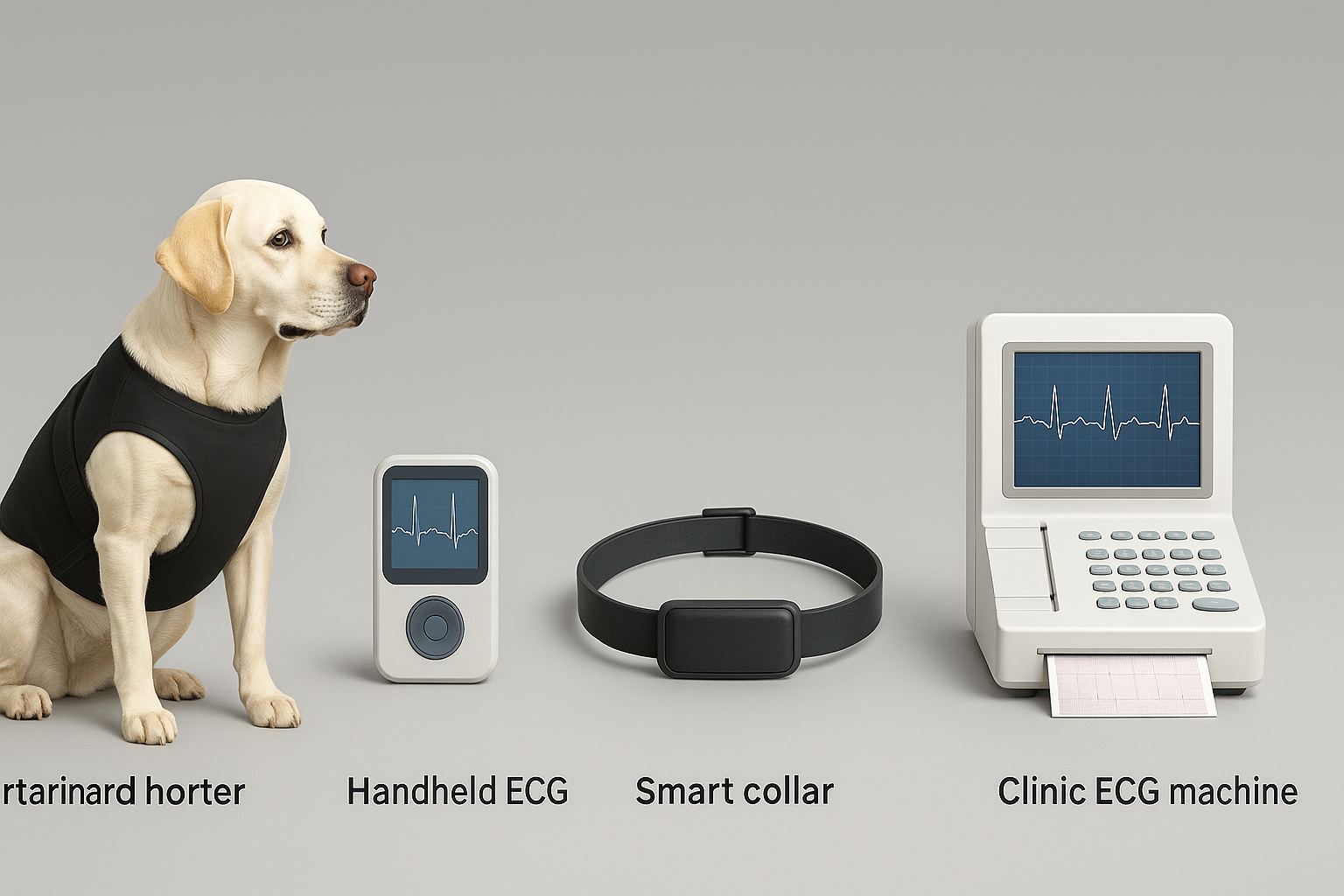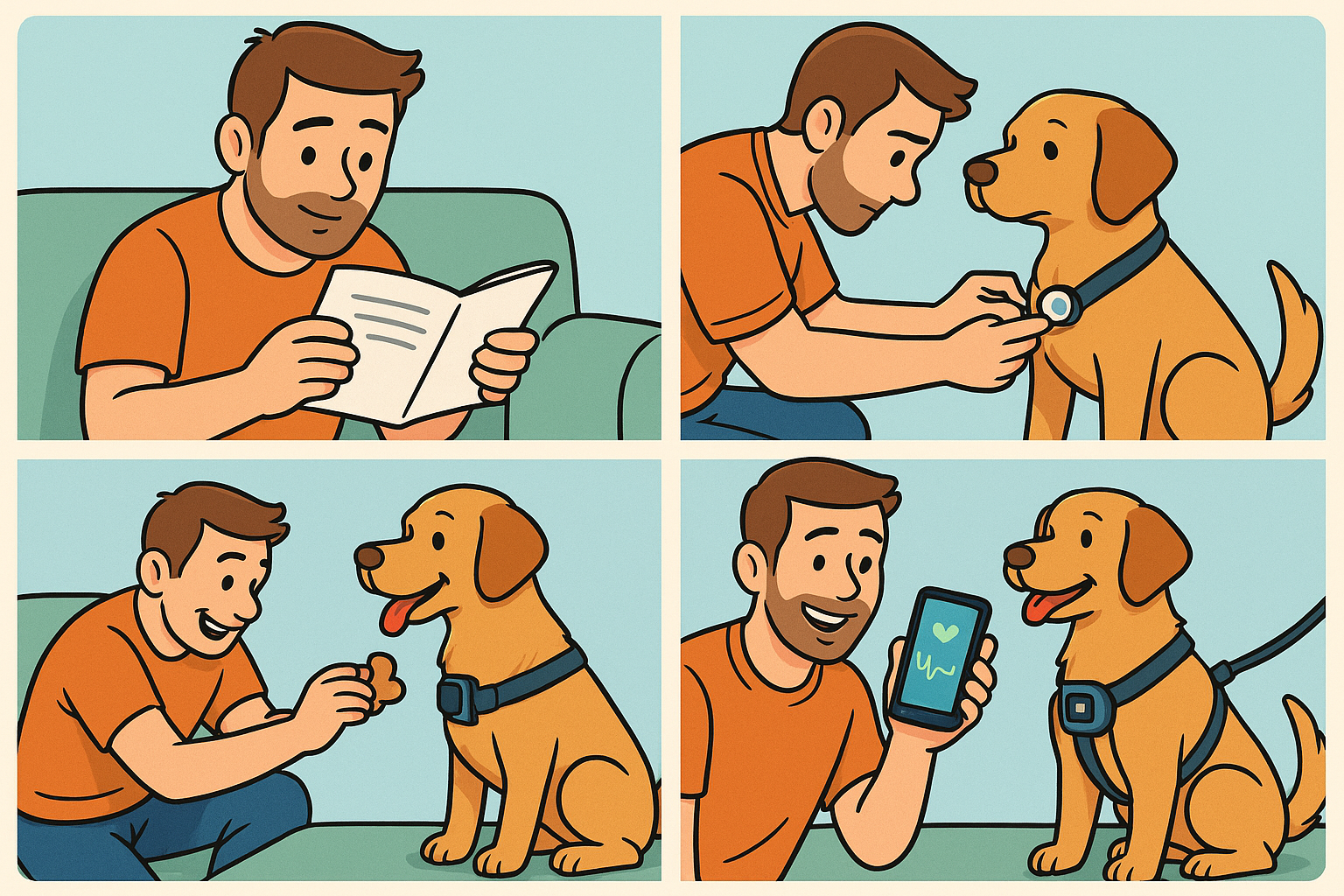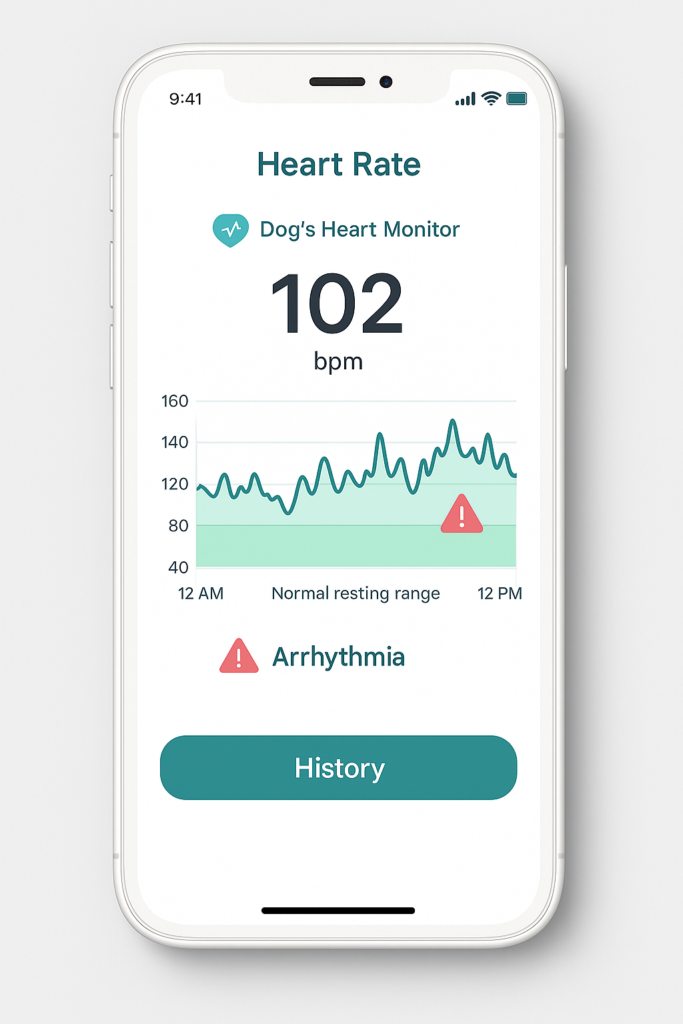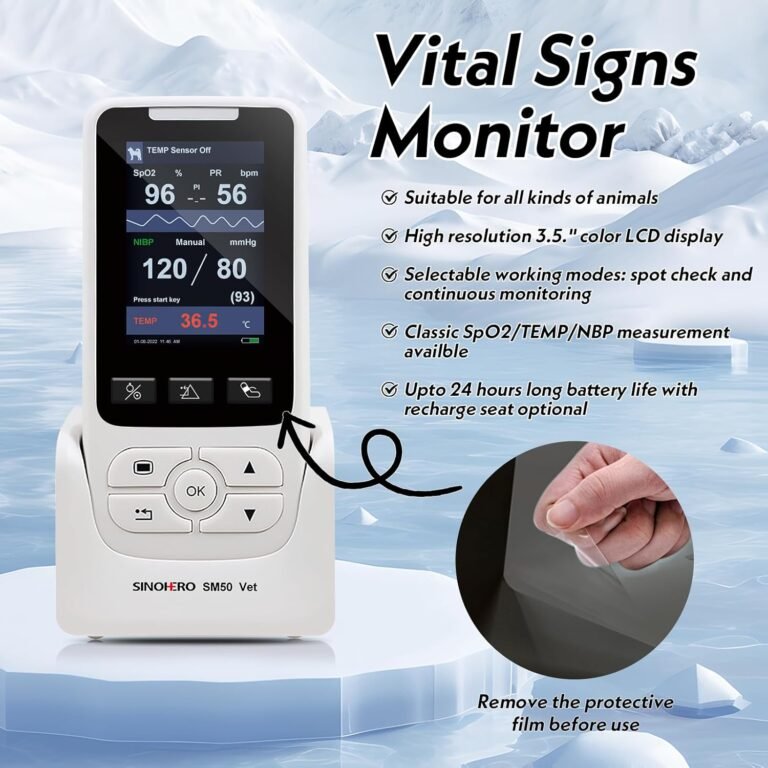
Introduction
In the world of pet care, it’s no secret that dogs hold a special place in our hearts. They greet us enthusiastically after a long day, offer unconditional love, and quickly become beloved members of the family. Naturally, we want to do everything in our power to ensure they remain healthy and happy. One vital aspect of their well-being often overlooked by dog owners is their cardiac health. That is where the concept of a heart monitor for dogs comes into play.
A heart monitor for dogs can help owners keep a close eye on their pet’s heart rate, detect potential health issues, and provide valuable data that veterinarians can use for accurate diagnoses. These devices range from simple, consumer-friendly options to more advanced clinical tools like Holter monitors used in veterinary medicine. In this article, we will delve deep into the world of canine cardiac health, exploring the science behind dog heart function, signs of potential cardiac problems, and how a heart monitor for dogs can assist in maintaining optimum health. By the end, you’ll have all the information necessary to decide if a heart monitor could benefit your furry friend.
Understanding Dog Heart Health
How Does a Dog’s Heart Work?

A dog’s heart functions similarly to a human’s heart. It pumps oxygenated blood throughout the body to supply tissues and organs with the oxygen and nutrients they need. The heart is divided into four chambers (left atrium, left ventricle, right atrium, and right ventricle) with various valves regulating blood flow between these chambers and ensuring that blood flows in only one direction. The contraction and relaxation of the heart create the heartbeat, a vital indicator of overall cardiovascular function.
Factors Affecting Canine Cardiac Health
Several factors influence a dog’s heart health:
-
Genetics – Certain breeds (like Cavalier King Charles Spaniels, Boxers, and Doberman Pinschers) are more prone to congenital heart defects or inherited conditions such as cardiomyopathy and mitral valve disease.
-
Diet – A nutrient-deficient or unbalanced diet can negatively impact cardiac health by leading to obesity, high blood pressure, or other metabolic issues.
-
Exercise Level – Both insufficient and excessive exercise can stress the heart. Finding a balanced routine that fits your dog’s size, breed, and energy level is key.
-
Age – As dogs age, the likelihood of degenerative heart disease increases. Regular vet check-ups become even more important as your dog grows older.
-
Underlying Health Conditions – Issues like kidney disease, thyroid imbalances, and chronic infections can affect the heart.
![]()
Understanding how these factors interplay helps dog owners anticipate potential problems and take proactive steps. One of the best tools to monitor these variables is a heart monitor for dogs which offers real-time insights and data.
Signs and Symptoms of Heart Issues in Dogs
Keeping an eye out for early warning signs of heart disease or other cardiac problems is crucial. The following symptoms might indicate your dog has a heart-related issue:

-
Persistent Coughing: A cough that doesn’t improve with conventional treatment can be a symptom of fluid buildup in the lungs (pulmonary edema), common in heart conditions.
-
Exercise Intolerance: If your dog becomes easily tired or has difficulty keeping up during normal activities, it could be a red flag.
-
Rapid Breathing or Panting: Consistently abnormal or labored breathing when at rest might indicate heart trouble.
-
Fainting or Collapsing: These episodes, known as syncope, can be triggered by inadequate blood flow to the brain due to poor heart function.
-
Distended Abdomen: Fluid accumulation in the abdomen (ascites) can be a sign of right-sided heart failure.
-
Loss of Appetite and Weight Loss: Heart disease can cause a lack of appetite and gradual weight reduction due to reduced energy levels and overall poor health.
-
Lethargy: Unusual drowsiness or lack of interest in daily activities can be an early hint of cardiac complications.
If you notice one or more of these symptoms, consult a veterinarian promptly. For more detailed information on common heart conditions in dogs, check out PetMD: Common Heart Conditions in Dogs. Early diagnosis and treatment significantly improve a dog’s prognosis. To assist in early detection, a heart monitor for dogs can be an excellent tool, ensuring you track your dog’s heart rate and rhythm patterns over time.
What Is a Heart Monitor for Dogs?
A heart monitor for dogs is a device designed to record and analyze a dog’s heart activity. It typically measures parameters such as:
-
Heart Rate (HR)
-
Electrocardiogram (ECG) / EKG
-
Heart Rhythm (looking for arrhythmias or irregularities)
Veterinary professionals often use clinical-grade heart monitors (like Holter monitors) for specialized examinations, while pet owners might choose more simplified versions or wearable dog heart rate trackers. These monitors help track:
-
Resting heart rate (normal range varies by breed and size)
-
Activity-based heart rate (during walks, runs, or play sessions)
-
Arrhythmias or episodes of irregular heartbeat
In essence, a heart monitor serves as an early detection device, gathering crucial data that can help identify potential health issues before they escalate. Beyond diagnosis, monitoring is often required for dogs with diagnosed cardiac conditions to evaluate treatment progress and adjust therapies.
Types of Heart Monitors
When it comes to finding a suitable heart monitor for dogs, it’s important to realize there isn’t a one-size-fits-all solution. The type you choose will depend on your dog’s condition, your budget, and the level of detail you need.

Veterinary Holter Monitors
Holter monitors are the gold standard for diagnosing and tracking cardiac issues in both humans and animals. Veterinarians often recommend these for dogs suspected of having severe arrhythmias or more complex heart problems. These devices record an ECG continuously for 24 to 48 hours (or more), offering a comprehensive picture of your dog’s heart activity during daily routines.
Pros:
-
Offers the most comprehensive ECG data
-
Highly accurate
-
Essential for diagnosing serious or complex conditions
Cons:
-
Expensive
-
Requires professional placement and analysis
-
Dog must wear the device for extended periods, which may be uncomfortable
Wearable Pet Trackers with Heart Rate Monitoring
In recent years, consumer-friendly, wearable pet trackers have surged in popularity. Some advanced devices now include heart rate monitors. These can be attached to a collar or harness and can measure real-time heart rate while also tracking activity levels, sleep patterns, and more.
Pros:
-
Easy to use
-
Offers valuable data for overall wellness
-
Often syncs with smartphone apps for instant updates
Cons:
-
Not as detailed as a clinical-grade ECG
-
May not be suitable for diagnosing complex heart issues
-
Accuracy may vary
Veterinary Clinic ECG Machines
For immediate, in-office assessments, veterinary clinics use ECG machines to gather a snapshot of your dog’s heart function. While not typically referred to as a “monitor” you keep at home, these machines provide your veterinarian with quick diagnostic data during routine check-ups or emergencies.
Pros:
-
Quick and accurate readouts
-
Allows your vet to make immediate decisions
-
Non-invasive
Cons:
-
Not designed for long-term or continuous tracking
-
Requires a trip to the vet’s office
Handheld ECG Devices
Handheld ECG devices are portable units that veterinarians can use during house visits, or owners can potentially purchase for at-home monitoring under professional guidance. They provide more detail than a basic wearable tracker but can still be less comprehensive than a continuous Holter monitor.
Pros:
-
Portable and lightweight
-
More comprehensive than a standard heart rate tracker
-
Great for intermittent spot-checks
Cons:
-
May not capture intermittent heart irregularities that occur outside the monitoring window
-
Requires some user skill or knowledge to attach leads properly
When choosing a heart monitor for dogs, consult with your veterinarian. They can help you weigh the advantages and disadvantages of each option, ensuring the type of monitor suits both your dog’s medical needs and your financial considerations.
How to Choose the Right Heart Monitor for Your Dog
Selecting the most appropriate heart monitor for dogs depends on several factors:
-
Purpose and Condition: If your dog has already been diagnosed with a serious heart condition and needs extensive monitoring, a Holter monitor might be best. For general wellness tracking, a wearable heart rate monitor could suffice.
-
Budget: Clinical-grade monitors or professional Holter rental can be expensive. Weigh the potential medical benefits against the cost to find a solution that meets your dog’s needs without breaking the bank.
-
Ease of Use: If you’re new to heart monitoring, look for a device with simple instructions, minimal leads, or user-friendly smartphone integration.
-
Size and Fit: Ensure the monitor is comfortable and properly sized. Some dogs may have trouble adjusting to wearing a bulky device for long periods.
-
Data Accuracy and Accessibility: Look for monitors with proven accuracy, consistent performance, and accessible data formats. The device’s software or app should allow you to easily interpret heart rate trends or share them with a vet.
Benefits of Using a Heart Monitor for Dogs
Early Detection of Heart Problems
A primary benefit of using a heart monitor for dogs is the ability to catch heart-related issues in their early stages. Irregular heartbeat patterns, rising resting heart rates, or unusual rhythms can be detected long before major symptoms manifest.
Continuous or Regular Monitoring
Dogs with pre-existing heart conditions or those in high-risk categories can greatly benefit from continuous or periodic heart monitoring. This helps in:
-
Tracking treatment effectiveness
-
Adjusting medications as needed
-
Detecting sudden changes in cardiac function
Peace of Mind for Pet Owners
Owning a high-quality heart monitor provides reassurance that you’re actively safeguarding your dog’s health. You gain immediate insights into your pet’s cardiac function, ensuring no unwelcome surprises.
Improved Veterinary Collaboration
When you can share accurate, long-term data with a veterinarian, it improves the likelihood of correct diagnoses and effective treatments. Many heart monitors for dogs store or sync data that can be examined by vet professionals, creating a cohesive approach to your dog’s wellness.
Supports Overall Health Monitoring
Many modern wearable monitors also track calorie expenditure, distance traveled, and sleep patterns. These additional metrics can help you develop a more comprehensive view of your dog’s health, from weight management to activity optimization.
Getting Started: Setting Up Your Dog’s Heart Monitor
Whether you’ve decided on a wearable heart rate tracker or a professional Holter monitor, setting up the device properly will ensure you get reliable data.

-
Read the Instructions Thoroughly: Different models require specific steps for attaching sensors or leads. Familiarize yourself with the user manual to avoid mistakes.
-
Clean and Prepare the Application Site (if required): For Holter or ECG monitors, shaving a small area to adhere electrodes might be necessary. Clean the skin to remove any oils that might disrupt the signal.
-
Calm Your Dog: Anxiety can elevate a dog’s heart rate, skewing the data. Introduce the device slowly, offering treats or praise to make the process positive.
-
Secure Properly: Ensure the monitor or harness fits snugly but not too tightly. Improper placement can lead to inaccurate readings or discomfort for your dog.
-
Perform a Test Reading: Check if the heart rate or ECG trace looks stable. If you notice irregularities (like frequent drops in signal), reposition the device or contact customer support (for wearable trackers) or a vet (for clinical devices).
-
Establish a Routine: For daily heart rate checks, do it around the same time to maintain consistent comparisons. If you’re using a continuous monitor, follow your vet’s recommendations for how long to keep it on.
Interpreting the Data from a Heart Monitor

A heart monitor for dogs can generate a wealth of data. Here’s how to make the most of it:
-
Heart Rate (BPM): Keep track of your dog’s normal resting heart rate. Small breeds generally have higher heart rates (around 100-140 BPM), while large breeds have slower rates (around 60-100 BPM). Any consistent deviation from your dog’s known baseline might indicate a problem.
-
ECG Tracing: If you’re using a device that records an ECG, look for any irregularities like extra beats, skipped beats, or prolonged intervals. Intermittent episodes of arrhythmias can be key indicators of underlying disease.
-
Trends Over Time: A single reading offers limited insights. Monitoring trends across days or weeks provides a more accurate assessment. Look for gradual increases or decreases in heart rate or the frequency of arrhythmias.
-
Share with Professionals: If your heart monitor allows export or cloud syncing, provide this data to your veterinarian. This insight might guide medication adjustments, dietary changes, or additional diagnostic tests.
Tips for Maintaining Your Heart Monitor
Ensuring your heart monitor for dogs remains functional and accurate requires proper care and maintenance:
-
Regular Cleaning: Wipe down the surface of the monitor and electrodes (if applicable) after each use with a damp cloth or an approved cleaner. For harness-style monitors, wash the harness per the manufacturer’s instructions.
-
Check Batteries and Firmware: Keep the device’s battery charged or replaced as needed. If the monitor has firmware or software, ensure it’s up to date.
-
Inspect for Wear and Tear: Over time, wires, straps, or adhesives can degrade. Replace these components promptly to maintain accuracy.
-
Store Properly: Store the monitor in a cool, dry place away from direct sunlight when not in use.
-
Monitor Calibration: Some monitors require periodic calibration. Follow any instructions provided by the manufacturer or your veterinarian.
Lifestyle Changes to Support Your Dog’s Heart Health

A heart monitor for dogs is an essential tool, but it’s just one part of a holistic approach to canine heart health. Consider incorporating the following measures:
-
Balanced Diet:
-
Choose high-quality dog food rich in lean protein, healthy fats (like omega-3 fatty acids), and essential vitamins.
-
Avoid excessive treats or table scraps that lead to weight gain.
-
Consult your veterinarian for specialized heart-healthy diets if your dog is predisposed to cardiac issues.
-
-
Consistent Exercise:
-
Tailor the exercise routine to your dog’s breed, size, and health status.
-
Activities like daily walks, gentle play sessions, or light jogging can keep your dog’s heart in good shape.
-
Monitor your dog’s heart rate during exercise to avoid overexertion.
-
-
Weight Management:
-
Maintain a healthy weight to reduce stress on the heart.
-
Regular weigh-ins and adjustments in meal portions can help achieve an optimal body condition score.
-
-
Stress Reduction:
-
Chronic stress can affect cardiac function.
-
Provide a calm environment, ample social interaction, and mental stimulation through puzzle toys or training exercises.
-
-
Regular Vet Check-ups:
-
Annual or biannual vet visits are vital for early detection of heart issues.
-
Discuss the use of a heart monitor with your vet if your dog is at risk.
- Visit reputable veterinary resources, like VCA Hospitals: Heart Disease in Dogs, to stay informed about important health considerations.
-
-
Avoid Secondhand Smoke and Environmental Pollutants:
-
Exposure to smoke can exacerbate respiratory and cardiac issues in dogs.
-
Keep your home environment as clean as possible.
-
By incorporating these lifestyle changes, you can maximize the benefits of monitoring and help ensure your dog’s heart remains strong and healthy for years to come. For in-depth information on advanced cardiology in veterinary medicine, you may explore the ACVIM: Canine Cardiology Resources. These additional insights can help you and your vet formulate a comprehensive treatment or monitoring plan, if needed.
Frequently Asked Questions (FAQs)
At what age should I start using a heart monitor for my dog?
While there’s no hard rule, it’s advisable to begin routine monitoring if your dog is a breed prone to cardiac issues, is overweight, or shows early signs of heart disease. Many owners start monitoring in middle age or earlier if recommended by a vet.
How often should I use a heart monitor for dogs?
The frequency depends on your dog’s health status. For general well-being, occasional checks may suffice. For dogs with diagnosed conditions, your vet may recommend continuous or daily monitoring. Always follow professional guidelines.
Can I use a human heart monitor on my dog?
Generally, it’s not recommended. Human heart rate monitors are calibrated for human physiology. Dogs have different coat densities, chest shapes, and heart rate ranges, making specialized devices more accurate.
Are heart monitors for dogs expensive?
Costs vary widely. Simple heart rate trackers might be under $100, while renting or purchasing a professional Holter monitor can run into hundreds of dollars. Consider your dog’s specific needs and consult a veterinarian.
How do I know if my dog’s heart rate is normal?
Normal heart rate ranges vary by breed and size. Small dogs can have resting heart rates up to 140 BPM, while larger dogs might be in the 60-100 BPM range. Track your dog’s baseline and look for changes.
Will my dog be uncomfortable wearing a heart monitor?
Some dogs may need time to adjust, especially with devices like Holter monitors that require multiple leads or a vest. Proper fit and training can reduce discomfort. Short-haired dogs may benefit from protective clothing to prevent skin irritation from adhesives.
Is a heart monitor a substitute for veterinarian visits?
No. A heart monitor for dogs is a supplementary tool. It can provide valuable data, but only a trained veterinarian can interpret results fully, diagnose conditions, and prescribe treatments.
What if I see abnormal heart rate readings but no symptoms?
Contact your veterinarian. Sometimes changes can be due to stress, device error, or environmental factors. However, an abnormal reading may also indicate an early problem. It’s best to consult a professional rather than self-diagnose.
Will insurance cover the cost of a heart monitor?
This depends on the insurance policy. Some pet insurance plans may cover part or all of diagnostic tools if deemed medically necessary. Check your plan’s details or consult with your insurance provider.
How do I clean the monitor’s electrodes if my dog gets dirty?
Use gentle, vet-approved cleaning solutions or wipes. Avoid harsh chemicals or soaking the device, which could damage internal components. Refer to the manufacturer’s guidelines for thorough instructions.
Conclusion

A heart monitor for dogs can make a profound difference in ensuring your canine companion remains healthy and happy. From early detection of heart disease to providing peace of mind during daily activities, these devices bridge a critical gap between owner observation and professional veterinary care. By choosing the right monitor, setting it up correctly, and interpreting the data in collaboration with a veterinarian, you can play a pivotal role in safeguarding your dog’s heart health.
Remember that a heart monitor is just one tool in a larger wellness strategy. Emphasizing a balanced diet, routine exercise tailored to your dog’s breed and medical needs, and regular veterinary check-ups will complement the insights gleaned from heart monitoring devices. These combined efforts can significantly improve both the quality and length of your dog’s life.
Whether you’re a concerned pet parent of a breed predisposed to cardiac issues or simply vigilant about your dog’s overall health, a heart monitor for dogs offers invaluable insights. By being proactive and informed, you can help your furry friend thrive and enjoy many more wagging-tail years by your side.


